Acute Lymphoblastic Leukemia (ALL): Tom's Story
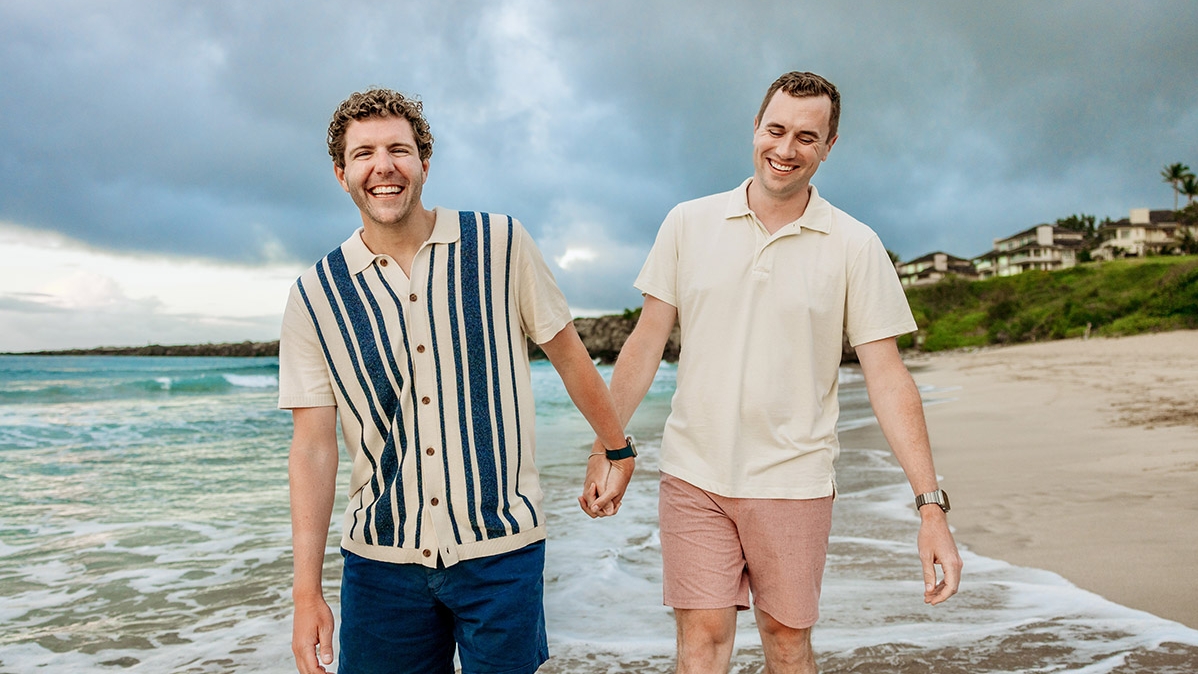
Tom Grabiak
Erie, Colorado
Acute Lymphoblastic Leukemia (ALL)
Transplanted in 2023
Many thanks to Colorado Blood Cancer Institute, the American Society for Transplantation and Cellular Therapy, and Incyte for helping us share Tom’s story.
Give us a snapshot of your life before illness: where were you living, and working? What did you most enjoy doing?
In 2018, I married my husband, also Tom, and we live near Boulder, Colorado. Beginning in 2021, we began planning to grow our family through surrogacy.
Living here in the Rockies invites you to be incredibly active, and we were enjoying all Colorado has to offer. I’ve always been athletic. I swam competitively in high school and college, and I love skiing, hiking, tennis, and running. In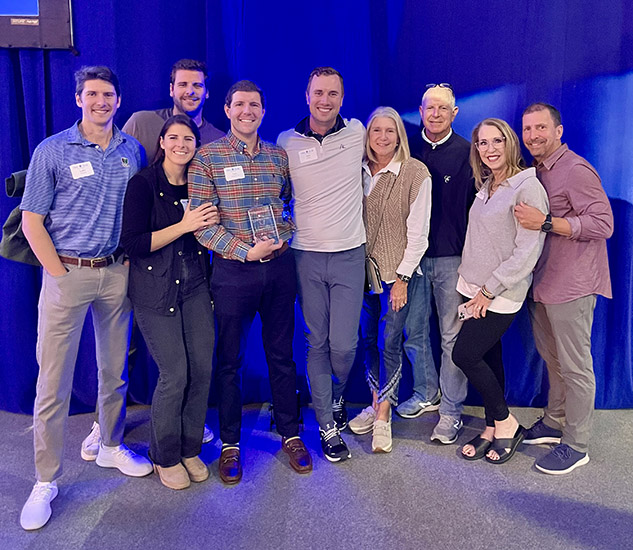 a typical week, before I got sick, I might bike on my Peloton, run, lift weights, and hike with our two dogs, Mila and Marley. My husband and I liked to bring the dogs with us everywhere we went.
a typical week, before I got sick, I might bike on my Peloton, run, lift weights, and hike with our two dogs, Mila and Marley. My husband and I liked to bring the dogs with us everywhere we went.
Strangely, my fitness routine turned into ground zero for “something is not right here.”
How was your fitness routine “ground zero”?
Around Thanksgiving of 2022, normal things like walking up stairs or exercising began to elevate my heart rate intensely; I could see this unusual data on my Apple watch. At first, I attributed a higher heart rate to indulging over the holidays.
At Christmas, we took a road trip to visit my family in Ohio and attend a wedding in Arkansas. In Ohio, we love to play tennis, and I could not play. I had to stop because I was so out of breath. I felt pretty defeated.
The same thing happened when I tried to go on a family run. It was painful not to be able to exercise like I usually do. I wasn’t really scared (yet), but a couple of days before New Year’s Eve, when my husband saw a rash on my side, we were both dumbfounded. At first, we thought it might be an allergic rash, but when it spread to the inside of my mouth and my lower lip, we recognized it might be petechiae.
We knew I needed to be checked out. Urgent care sent me immediately to a local emergency room, where I received a pseudo diagnosis – “You have leukemia.” They weren’t positive, but it seemed likely.
On New Year's Eve, we drove from Arkansas back to Colorado, Googling all the way home. I’m calling cancer centers and getting holiday messages. I didn’t even know what to say. I didn’t have a full-blown diagnosis yet, but I was trying to get someone to quarterback my health on New Year’s Eve! Fortunately, we have doctors in our family who helped calm me down a bit.
When you got home, where did you find help, and what was your early treatment like?
Initially, I found help at The Rocky Mountain Cancer Center and Boulder Community Health; they kick-started everything, including diagnosis and initial treatment. At that point, my white blood count was astronomically high, and my platelets were really low.
Before we could begin chemotherapy, I required a PICC line. They put the line in surgically, but afterward, I could not stop bleeding. They kept trying to wheel me out of the operating room, but I’d be bleeding down the wheelchair, and they’d have to bring me back to stop it.
My blood counts were so unstable that I spent an entire day receiving back-to-back transfusions to keep me alive - platelets, then more platelets, then red blood cells, then back to platelets. My nurse that day, Caitlin, was a godsend! Her energy and spirit helped get me through. I’ve never seen someone work so hard to keep someone else alive.
Also, my husband and my mother, Susan, stayed right by my side, distracting me with games and laughter. At the time, I really didn’t know what any of this meant. I intentionally didn’t do a whole lot of reading about my prognosis or survival rates. I just trusted my health care team. I resolved to be a good patient and follow instructions and not introduce any information that might derail the process I was in, day by day.
Can you talk a little bit more about that mindset as a patient?
I’m a very disciplined person, so if the doctors say “do this,” that’s what I’m gonna do. If it’s sitting still and trying not to lose your mind, I’ll do it! I was very engaged in day-to-day activities and therapies, but intentionally unaware of the overall prognosis. That’s what worked best for me.
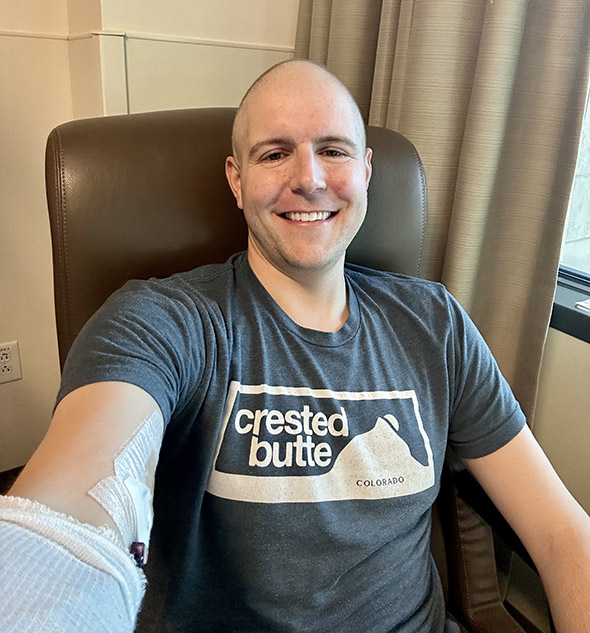 Which is not to say I didn’t have questions… I had a ton of questions! But I knew that asking the big questions like “why did this happen to me” would never yield an answer. I asked questions about drugs: What is this going to do? How is this going to make me feel? I wanted to understand how everything I was doing would enable me to reach the next stage of healing.
Which is not to say I didn’t have questions… I had a ton of questions! But I knew that asking the big questions like “why did this happen to me” would never yield an answer. I asked questions about drugs: What is this going to do? How is this going to make me feel? I wanted to understand how everything I was doing would enable me to reach the next stage of healing.
For me the scariest and hardest part of early treatment was intrathecal chemotherapy (chemotherapy drugs injected into the fluid that surrounds the brain). I was supposed to have 12 doses, and I didn’t understand why – I had no disease in my spinal column or my brain. I was frustrated and confused. If you’re going into my spine 12 times, I need to know why! The answer was that these are locations where disease can potentially spread. It was the standard of care. I did it.
Fortunately, I always saw progress. I had faith both because I trusted my team and because I could see that what they prescribed was making a difference. I also knew that becoming disease-free was the key step to a total cure, through transplant.
Was there a moment when you knew that you were definitively disease-free?
After my first round of chemo was complete, I felt good enough to travel to Ohio to celebrate some family milestones. On the way home, I got a call from an unknown number. My husband and parents-in-law were also in the car. It was my care team calling with an update. They started giving me the news, but we had a bad connection and the call dropped! So did my heart, thinking about the results…
Fortunately, they called right back, and they told me I was cancer-free and MRD negative! (MRD Negative means no detectable cancer cells remain in the body.) A wave of emotions hit me, and tears of relief streamed down my face. I was at a loss for words. The happiness I felt in that moment was unmatched. Most of all, it meant I was able to move forward to transplant.
Did you find a donor easily? And once you had a donor, how did you feel about the prospect of receiving a bone marrow transplant?
I am one of four kids, so we tested all three of my siblings. My sister and one brother were not full matches, but my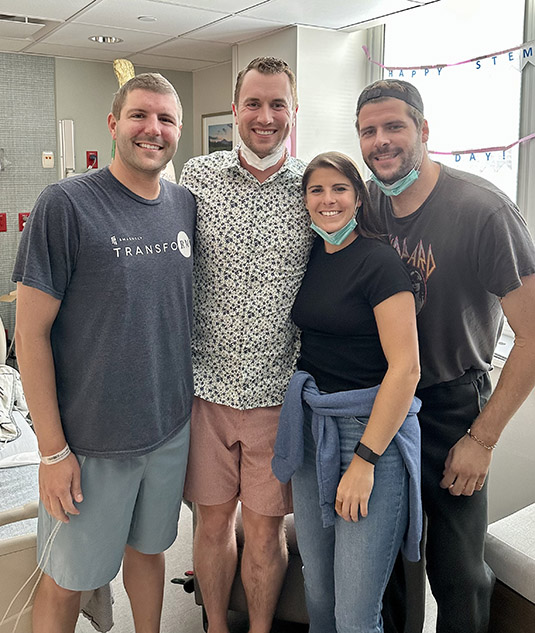 brother, Matthew, was a 100% match. Any one of us would donate to any of the others. I’m so grateful to Matthew for this gift. We have always been close, and this experience brought us closer.
brother, Matthew, was a 100% match. Any one of us would donate to any of the others. I’m so grateful to Matthew for this gift. We have always been close, and this experience brought us closer.
We were all really surprised and relieved that the transplant is not like an organ transplant. Bone marrow transplant is incredibly anticlimactic, and that is a good thing!
In June of 2023, I went into transplant with no preexisting conditions and as a very fit, healthy person. This allowed my body to really cope with high-dose chemo and total body radiation. The chemo was easy, you sit there and they hang the medication. But radiation was so isolating. Quite literally, I was in a vulnerable position, both metaphorically and physically. It culminated in radiation to my testicles on the last session, fully directly on my groin area. I felt so exposed. Having to do that was really tough.
I was very fortunate in that I had little to no pain throughout all this. I don’t know if I’m an outlier, but I felt very lucky. I had emotional pain for sure, but no physical pain to speak of!
Your transplant was in 2023. In the two years since, how has your health been? And, do you feel personally changed, in any fundamental ways, by this experience?
I have had some mild graft-versus-host disease (GVHD). The joints in my elbows, shoulders, and legs have been affected. My symptoms were triggered by my one-year post-transplant vaccinations. After a failed attempt at steroid treatment, I went on Jakafi and it worked immediately. I’m tapering off, and hope to be Jakafi-free by Winter 2025!
Recovery felt slow, day by day, but in retrospect, it was quick. My transplant was in early June, and I was back to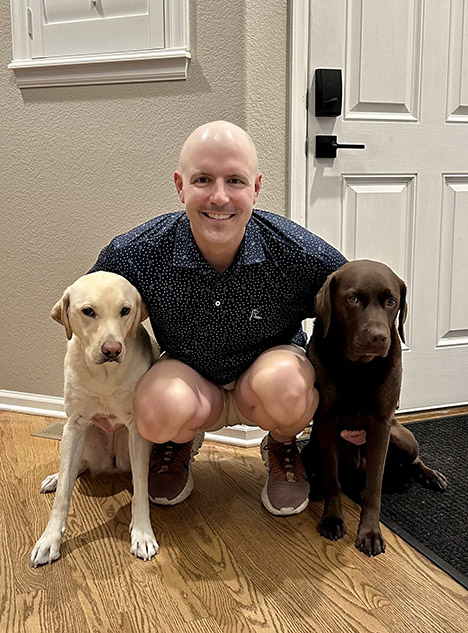 work by August 3rd. My employer, Google, was a world-class partner in helping me and my family get through this. They offered an excellent health plan, generous short- and long-term medical leave, flexible work arrangements, and an empathetic team and manager. I truly couldn’t ask for more.
work by August 3rd. My employer, Google, was a world-class partner in helping me and my family get through this. They offered an excellent health plan, generous short- and long-term medical leave, flexible work arrangements, and an empathetic team and manager. I truly couldn’t ask for more.
On a personal level, this experience has made me more patient. It has made me more present. And it has reaffirmed that the way I choose to live my life is beneficial. I was able to endure all the punishing treatments because those years dedicated to athletics really paid off. Fitness helped me get through this physically, but also emotionally. Moving gave me the confidence that I could get through each day and thus through the whole process.
I’m also full of gratitude. Most of all for my husband Tom. Starting with the night he drove us home from Arkansas to Colorado while I Googled leukemia, he’s been my rock. He accepted the limitations of what I had to give each day.
My family is also amazing. My mom and my dad made countless visits when I was in the hospital. Of course, my brother Mathew made this whole thing possible. My sister Emily was literally in touch with me every single day, consoling me, or distracting me with her silly dramas. Plus, we’re lucky because my husband and his family get along so well with mine – it’s like we have always been one big family.
Looking at your life post-transplant, what brings you the most joy?
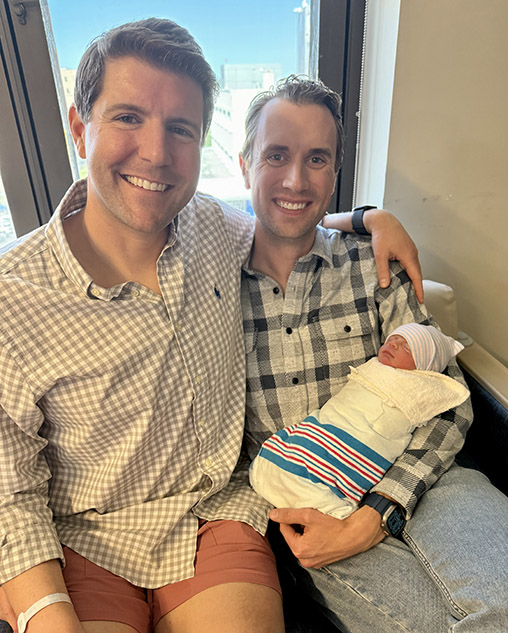
On April 9th, we welcomed our son, Oliver, into our lives. My husband and I had been working on this since 2021, and fortunately, getting sick didn’t delay anything. Before leukemia came into the picture, I had done all I needed to for fertility. We matched with a surrogate during my recovery. So now our family of three is: Tom, Tom, and Oliver. Right now, I am talking to you while on parental leave from my job. I am so thankful to be on leave from work, not for sickness or treatment, but for baby bonding time!
Oliver’s birth is truly the best gift I could have asked for. I’ll take being healthy… but being a dad is something that’s irreplaceable. I am lucky, I am really, really lucky. I went from the worst possible news you can get, to a cure, to having the family of our dreams.
Any last thoughts or appreciations to share?
I want to give one last shout-out to my coordinator at Colorado Blood Cancer Institute, Kaitlyn. I can’t even put into words how much she’s helped me – from answering silly questions to calling in script refills, to scheduling appointments, to dealing with my highs and lows. She is the best person I’ve ever dealt with in a healthcare setting, and without her, I would not be where I am today.

Colorado Blood Cancer Institute (CBCI), a part of the Sarah Cannon Cancer Institute at Presbyterian St. Luke’s Medical Center, is a FACT accredited program that provides comprehensive hem-malignancy care including autologous and allogeneic stem cell transplant and is a certified commercial and research CAR T provider. CBCI also performs transplants for autoimmune disorders and multiple sclerosis. CBCI is celebrating its 30th Anniversary as a transplant program and has performed over 5300 BMT’s since its inception and we perform > 330 transplants annually. We are committed to scientific investigation of the most progressive treatments dedicated to curing cancer.

The American Society for Transplantation and Cellular Therapy (ASTCT), formerly known as the American Society for Blood and Marrow Transplantation, is a professional society of more than 2,200 healthcare professionals and scientists from over 45 countries who are dedicated to improving the application and success of blood and marrow transplantation and related cellular therapies. ASTCT strives to be the leading organization promoting research, education, and clinical practice to deliver the best, comprehensive patient care.